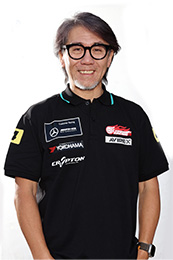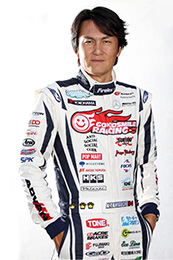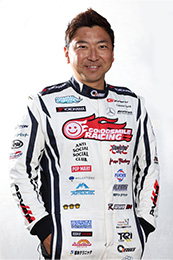GOODSMILE RACING & TeamUKYO RACE REPORT 3
2024 AUTOBACS SUPER GT Round3 SUZUKA GT 3Hours RACE
On the first weekend of June, the third round of the SUPER GT series, the “SUZUKA GT 3 Hours RACE,” took place.
Following the second round held at Fuji Speedway during Golden Week, this round also featured a three-hour endurance race. Each car was allowed to bring six sets of dry tires (and seven sets of wet tires). Additionally, teams were required to conduct two refueling pit stops during the race.
The Suzuka Circuit is known for its layout, which includes many medium- to high-speed corners that place significant loads on the tires. The aggressive nature of the track surface further adds to the difficulty, making it very tough on tires. Additionally, the track’s narrow width makes overtaking difficult during races. Therefore, it is crucial to quickly find the optimal setup during official practice sessions. With the newly introduced “combined time format” for qualifying this season, securing a spot at the front of the grid is key, as starting from a higher position is the shortest path to victory.
For this race, the Mercedes-AMG GT3 faced a Balance of Performance (BoP) adjustment. The air restrictor was changed back to 34.5mm for standard circuits, from the 35mm used at Fuji’s high-speed track, reducing the engine output as usual. The BoP weight also increased slightly from 35kg in the previous race to 40kg, with an additional 39kg added for safety measures, making the total weight reach 1,364kg. Furthermore, a success weight (SW) of 24kg was applied based on past results, likely to negatively impact tire performance. Drivers Nobuteru Taniguchi and Tatsuya Kataoka entered the race week prepared for a tough battle.
6/1 [Official Practice, Official Qualifying]
Weather: Sunny
Course: Dry
Temperature / Track Surface Temperature:
Before Q1: 26°C / 45°C
During Q2: 25°C / 43°C
The rain from the previous day had cleared, and the sky was bright and sunny from the morning. At 9:45 AM, when the official practice session began, the air temperature was 25°C, and the track temperature was 34°C, indicating the possibility of a hot day ahead. In these conditions, as the track opened, the No. 4 Good Smile Hatsune Miku AMG car started its run with Kataoka behind the wheel.
While many cars, especially GT500 class machines, waited in the pits for the track to rubber in, Kataoka was actively driving. On his fourth timed lap, he recorded a 2:00.535, followed by a 2:00.485, but couldn’t break below the 2-minute mark, leaving this as his best time of the practice session.
Although the lap times were far from the top and not in an ideal situation, Kataoka judged that “the car’s balance isn’t bad” in its initial state. He stepped out of the car early, leaving the remaining session to Taniguchi. Taniguchi then used the mixed running period to check the long-run pace, consistently maintaining stable lap times around the 2-minute 03-second range. During the 10-minute session dedicated to their class, he recorded his personal best time of 2 minutes 00.539 seconds. The two drivers completed a total of 31 laps, finishing the session in 18th position.
Notably, no Yokohama tire users managed to break into the top 10 during this session, leaving teams struggling with tire performance.
Following the session, Kataoka participated in the FCY (Full Course Yellow) test and the circuit safari, covering seven laps under FCY and six laps during the safari to fine-tune the setup ahead of the afternoon’s qualifying session.
This season’s qualifying format splits Q1 into two groups based on team rankings, with the top eight cars from each group advancing to the “Upper 16,” and the rest to the “Lower 17.” The final standings are determined by the combined times of Q1 and Q2. Unlike last season, where advancing to Q2 was the sole goal, the new format places more emphasis on achieving a fast lap time in Q1 as well.
Track conditions improve as cars lay down rubber, a phenomenon known as “track evolution,” making it advantageous to run later in the session. However, the starting order for each group is decided by a draw made by the winner of the previous race. While the #4 car had been fortunate to run second in the previous two races, this time, it was assigned to Group B, which would run first.
Kataoka was the Q1 attack driver. Of the 13 cars, six headed out onto the track as the session began. To offset the disadvantage of running first, the team opted to wait in the pits for about a minute, allowing the track to rubber in before launching their timed runs. With a plan to make their attack lap just before Q1 ended, the #4 car timed its departure from the pit carefully, alongside other rivals with similar strategies.
Kataoka recorded a 2:00.014 on his fourth lap, placing sixth. Although the #777 and #50 cars later moved ahead, dropping them to eighth, they managed to secure a spot in the “Upper 16” for Q2.
The Q2 “Lower 17” session concluded, and at 4:11 PM, the Q2 “Upper 16” session began. Under the new rules, only one set of tires can be used across Q1 and Q2. Taniguchi, continuing on the worn tires from Q1, warmed them up carefully to reactivate the grip. He recorded a 2:00.379 on his fourth lap, improving to a 2:00.107 on his next attempt. However, with the top cars breaking into the 1:58 range and many others below the 2-minute mark, this time placed them only 12th in the session. The combined time of 4:00.121 placed the #4 car in 13th for the “Upper 16.”
Due to the rules of the new qualifying format, the four lowest-placed cars in the “Upper 16” and the top four cars from the “Lower 17” are re-ranked based on their cumulative times. As a result, the #4 car became subject to “promotion/relegation” adjustments, ending up with a final qualifying position of 16th and starting from the 16th grid for the race the following day.
6/2 [Final]
Weather: Cloudy
Course: Dry
Air/Track Surface Temperature:
Prior to Start (1:30 PM): 25℃, 34℃
Early Race (2:00 PM): 24℃/34℃
Mid-race (3:00 PM) 24℃/31℃
End of Race (4:30 PM) 22℃/29℃
On Sunday, the sky was cloudy from the morning, and the weather forecast indicated a 50% chance of precipitation, suggesting that it would definitely rain in the afternoon. As predicted, light rain started to fall around the time the morning pit walk ended, and soon the track was completely wet.
The warm-up session starting at noon was declared a wet session, and cars fitted wet tires for the first time that weekend. Kataoka, driving the #4 car, repeatedly exited and re-entered the pit to scrub in the wet tires and prepare for the race.
However, the rain stopped midway through the session, and the track dried along the racing line, prompting teams to switch to slick tires for final checks.
By the time the 20-minute session ended and cars were positioned on the grid, the sun had reappeared, and the track was nearly dry.
At 1:30 PM, a parade lap led by seven police motorcycles and four patrol cars from the Mie Prefecture Police began, followed by a formation lap with the safety car, signaling the start of the 3-hour endurance race. Kataoka took the start from the 16th grid, equipped with slick tires for dry conditions, and dived into the first corner of the opening lap.
In the opening laps, the #65 car (LEON PYRAMID AMG) ahead lost two positions, while the #50 car (ANEST IWATA Racing RC F GT3) behind gained two, keeping the #4 car in 16th but with changed competitors ahead and behind.
Throughout the early phase of the race, the #4 car held its position, with Kataoka maintaining a steady pace in the 2:03 range and waiting for an opportunity to overtake.
On lap 11, as the #65, #5 (Mach Syaken Air Buster MC86), and #60 (Syntium LMcorsa GR Supra GT) cars engaged in a three-way battle ahead, the #60 car lost speed, allowing Kataoka to pass and move up to 15th. He attempted to overtake the #5 car but lost speed after a side contact during the chicane defense, missing the opportunity.
Kataoka eventually overtook the #5 car on lap 20, moving up to 13th place. As other competitors began their routine pit stops, the #4 car climbed to 11th on the next lap and 10th on lap 22. To keep options open for potential accidents, the team decided to stay out on track while others pitted. They instructed Kataoka to pit on lap 31 after reaching 5th place.
Kataoka handed over the car to Taniguchi, who would complete the remaining two-thirds of the race with a double stint. The #4 car rejoined the race after a full service, including a tire change and refueling.
Taniguchi reentered the track in 17th place, maintaining a steady 2:03 pace. Despite the lack of speed compared to the frontrunners, Taniguchi gradually closed the gap to the #62 car (HELM MOTORSPORTS GT-R), which was over 10 seconds ahead.
However, on lap 37, a Full Course Yellow (FCY) was deployed for debris retrieval due to a damaged GT500-class vehicle. Another FCY was issued on lap 46 when the #61 SUBARU BRZ R&D SPORT stopped by the side of the track, further disrupting the race pace. Despite these interruptions, Taniguchi managed to close the nearly 4-second gap to car #62 to 2.7 seconds by lap 48 when the FCY was lifted.
By lap 56, Taniguchi was right on the tail of car #62, looking for an opportunity to overtake. However, by this time, his tires were nearly at their limit, and he overshot the 130R corner. Ultimately, he couldn’t manage to pass car #62 on his own.
The team decided on their final routine pit stop on lap 58 and instructed Taniguchi to pit. The mechanics swiftly confirmed there was no damage from the earlier course-off, performed a full service, and sent him back on track in 14th position. With fresh tires, Taniguchi set his personal best lap times, recording 2:01.934 on lap 61 and 2:01.530 on lap 62.
On lap 63, Taniguchi overtook car #9 (PACIFIC NAC AMG), which had not made its second pit stop yet. On lap 65, the #5 pitted for its second stop, moving Taniguchi up to 12th place. By lap 74, he managed to pass car #20 (SHADE RACING GR86 GT), which had lost pace, closing in on 11th place.
However, with the finish line approaching at the 3-hour mark on lap 81, a combination of tire grip degradation and the engine’s weaker mid-range acceleration allowed car #62, which had been overtaken during the last pit stop, to move ahead again. The gap between them gradually widened, and Taniguchi ultimately finished in 12th place on lap 84. GSR was unable to secure points at the third Suzuka round of the season for the third consecutive year.
■Comments from the Team

We had higher expectations for Suzuka, considering our pre-event testing, but those expectations fell short right from the start of the weekend (laughs). We knew from the testing phase that we had a gap compared to others, but we didn’t anticipate the difference being this big. We had to make do with the tire sets we brought, deciding which ones could be used and which couldn’t, then using the remaining ones for qualifying and the race. We thought the testing would pay off, but it turned out the tires just weren’t good. Despite that, we aimed to earn points and strategized for it, but we might have been overly reliant on expecting rain, which backfired. Suzuka is a tough track to overtake on, and having a bit more power would have been nice, but honestly, if the tires had performed well (laughs), that would have made all the difference. That’s all there is to it this time.

We had already completed testing at Suzuka, so the car’s setup was pretty decent from the official practice. After that, it was just about having both drivers do their part. But since it’s June in Suzuka, we brought in summer-specific tires. We brought too many tires intended for hot conditions, and they turned out to be too hard. From the start, Dunlop, Bridgestone, Dunlop, Bridgestone, Michelin, Michelin… Yokohama users, in general, seemed to be struggling from the get-go. Even those who typically perform well, like car #88 (JLOC Lamborghini GT3) which won the previous race, and car #56 (Realize Nissan Mechanic Challenge GT-R), which is heavier this season, ended up near the bottom. It’s been tough for everyone (laughs). This time, it’s more of the same story, and that sums it up.

From the start, it was clear that only cars from other manufacturers were in the top positions—almost all Yokohama users struggled, so it’s obvious that the tires were a miss. We had a hunch from the pre-event testing at Suzuka, but once we got to the track that weekend and did the practice runs, it was like, “As expected?”… It’s that kind of sad feeling. The gap with other manufacturers was significant. Qualifying in 16th, finishing the race in 12th… we neither moved up nor down, it was just wasted effort (laughs and cries). We knew from the start that we wouldn’t have a chance in dry conditions, so we were hoping for something unusual to happen… like rain. But it ended up being a “looks like it might rain but never did” situation. Although, it’s not like I can say for sure we would have had a chance even if it had rained. It just feels empty this time… time to go home.

It was a weekend with no grip at all. We were at the back in qualifying, and in the race, we had no pace, and the tire wear wasn’t good either. There was nothing we could do. It didn’t rain, and we just finished in line with our performance, so this time, we need to figure out why there was no grip. Except for Ferrari, it seems like all the Yokohama cars struggled together. We need to review this as a group and share what we learn. Next is Fuji, which gives us some time to regroup. It’s the only place in the season where we might have a chance to compete, but we struggled with restrictor regulations last time too. But the key competitors around us should be getting heavier with Success Weight (SW) due to their results. We need to put this experience behind us and start fresh for the next race.






